L'Anse aux Meadows
| L'Anse aux Meadows National Historic Site* |
|
|---|---|
| UNESCO World Heritage Site | |
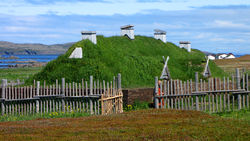 |
|
| State Party | |
| Type | Cultural |
| Criteria | vi |
| Reference | UNESCO World Heritage 4 |
| Region** | Europe and North America |
| Inscription history | |
| Inscription | 1978 (Second Session) |
| * Name as inscribed on World Heritage List. ** Region as classified by UNESCO. |
|
| L'Anse aux Meadows | |
|---|---|
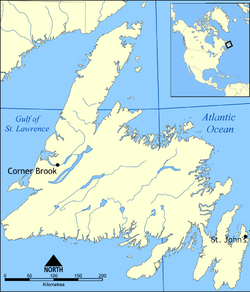 |
|
| Coordinates: |
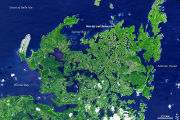
L'Anse aux Meadows (pronounced /ˈlænsi ˈmɛdoʊz/;[1] from the French L'Anse-aux-Méduses or "Jellyfish Cove") is an archaeological site on the northernmost tip of the island of Newfoundland in the Canadian province of Newfoundland and Labrador. Discovered in 1960, it is the only known site of a Norse village in Canada, and in North America outside of Greenland. The site remains the only widely-accepted instance of pre-Columbian trans-oceanic contact, and is notable for possible connections with the attempted colony of Vinland established by Leif Ericson around 1003, or more broadly with Norse exploration of the Americas.
Contents |
Etymology
The name "L'Anse aux Meadows" made its first appearance as Anse à la Medée on a map of 1862, when it may have derived its name from a ship called Medée. This was then modified by French-speaking fishermen during the nineteenth and twentieth centuries, who named the site L'Anse aux Méduses, meaning "Jellyfish Cove". The modern name is an English corruption of the French name, from Méduses to Meadows, which may have occurred because the landscape in the area tends to be open, with meadows.[2]
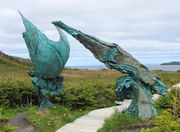
Discovery and significance
In 1960, the remains of a Norse village were discovered here by the Norwegian explorer Helge Ingstad and his wife Anne Stine Ingstad, an archaeologist. Archaeologists determined the site is of Norse origin due to definitive similarities between the characteristics of structures and artifacts found at the site compared to sites in Greenland and Iceland from around AD 1000.[3]
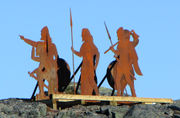
L'Anse aux Meadows is the only known Norse site in North America outside of Greenland, and represents the farthest known extent of European exploration and settlement of the New World before the voyages of Christopher Columbus almost 500 years later. It was named a World Heritage site by UNESCO in 1978.
Settlement
Archaeological excavation at the site was conducted in the 1960s by an international team led by Anne Stine Ingstad, and under the direction of Parks Canada of the Government of Canada in the 1970s. Following each period of excavation, the site was reburied to protect and conserve the cultural resources.
The settlement at L'Anse aux Meadows has been dated to approximately 1000 years ago, an assessment that agrees with the relative dating of artifact and structure types.[4] The remains of eight buildings were located. They are believed to have been constructed of sod (turf) placed over a wooden frame. Based on associated artifacts, the buildings were variously identified as dwellings or workshops. The largest dwelling measured 28.8 by 15.6 m (94.5 by 51 ft) and consisted of several rooms.[5] Workshops were identified as an iron smithy containing a forge and iron slag, a carpentry workshop, which generated wood debris, and a specialized boat repair area containing worn rivets. Besides those related to iron working, carpentry, and boat repair, other artifacts found at the site consisted of common everyday Norse items, including a stone oil lamp, a whetstone, a bronze fastening pin, a bone knitting needle, and part of a spindle. The presence of the spindle and needle suggest that women were present as well as men.[6] Food remains included butternuts, which are significant because they do not grow naturally north of New Brunswick, and their presence probably indicates the Norse inhabitants travelled farther south to obtain them.[7] Archaeologists concluded that the site was inhabited by the Norse for a relatively short period of time.
In addition to the European settlement, evidence of at least five or six separate native occupations has been identified at L'Anse aux Meadows, the oldest dated at roughly 6,000 years ago; none was contemporaneous with the Norse occupation. The most prominent of these earlier occupations were by the Dorset people, who predated the Norse by about 200 years.[8]
Connection with Vinland sagas
Norse sagas are written versions of older oral traditions. Two Icelandic sagas, commonly called the Saga of the Greenlanders and the Saga of Eric the Red, describe the experiences of Norse Greenlanders who discovered and attempted to settle land to the west of Greenland, identified by them as Vinland. The Sagas suggest that the Vinland settlement failed because of conflicts within the Norse community, as well as between the Norse and the native people they encountered, whom they called Skrælings.
Recent archaeological studies suggest that the L'Anse aux Meadows site is not Vinland itself, but was within a land called Vinland[7] that spread farther south from L'Anse aux Meadows, extending to the St. Lawrence River and New Brunswick. The village at L'Anse aux Meadows served as an exploration base and winter camp for expeditions heading southward into the Gulf of St. Lawrence.[7][9] The settlements of Vinland mentioned in the Eric saga and the Greenlanders saga, Leifsbudir (Leif Ericson) and Hóp (Norse Greenlanders), have both been identified as the site on L'Anse aux Meadows.[9]
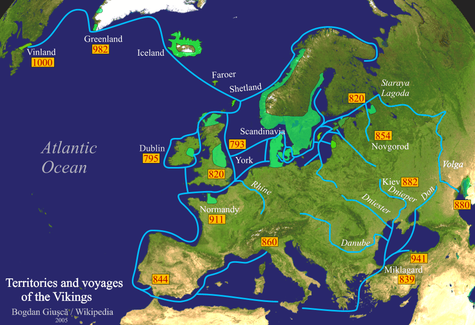
See also
- Thorfinn Karlsefni
- Helluland
- History of Greenland
- Former colonies and territories in Canada
- List of communities in Newfoundland and Labrador
- Markland
- Norse colonization of the Americas
- Pre-Columbian trans-oceanic contact
- Skálholt Vinland Map
- Skrælingar
- Vikings
- Vinland
- Vinland map
Notes
- ↑ Brave new world of the Vikings, Daily Mail, 26 August 2003
- ↑ Wahlgren, 1986, 2000, p.124.
- ↑ "L'Anse aux Meadows National Historic Site of Canada". Parks Canada. 2007. http://www.pc.gc.ca/lhn-nhs/nl/meadows/index_e.asp. Retrieved 008-02-12.
- ↑ Nydal, Reidar (1989). "A critical review of radiocarbon dating of a Norse settlement at L'Anse aux Meadows, Newfoundland, Canada". Radiocarbon 31: 976–985. http://www.digitalcommons.arizona.edu/objectviewer?o=http://radiocarbon.library.arizona.edu/Volume31/Number3/azu_radiocarbon_v31_n3_976_985_v.pdf.
- ↑ Canadian Encyclopedia article on L'Anse aux Meadows.
- ↑ "L'Anse aux Meadows National Historic Site of Canada". Parks Canada. 2008. http://www.pc.gc.ca/eng/lhn-nhs/nl/meadows/natcul/decouverte_discovery.aspx. Retrieved 2009-10-27.
- ↑ 7.0 7.1 7.2 "Is L'Anse aux Meadows Vinland?". L'Anse aux Meadows National Historic Site of Canada. Parks Canada. 2003. http://www.pc.gc.ca/lhn-nhs/nl/meadows/natcul/vinland_e.asp. Retrieved 2008-01-20. "...Vinland was a country, not a place..."
- ↑ "Aboriginal Sites". L'Anse aux Meadows National Historic Site of Canada. Parks Canada. 2003. http://www.pc.gc.ca/lhn-nhs/nl/meadows/natcul/sites_e.asp. Retrieved 2008-01-20.
- ↑ 9.0 9.1 Wallace, Birgitta; Gerhard E. Sollbach. "Vinland-Rätsel gelöst (Vinland Riddle Solved)" (in German). Damals 42 (5/2010): 47–48.
References
- Wahlgren, Erik 1986, 2000. The Vikings and America, Thames & Hudson Ltd, London. ISBN 0-500-28199-8.
External links
- L'Anse aux Meadows National Historic Site - official site at Parks Canada
- UNESCO
- Skálholt Map
- (English)+(French) 1001wonders.org : World Heritage sites in panophotographies - immersive and interactive panoramic images
Pictures
 L'Anse-aux-Meadows, Nfld, 2002 |
 Landing at L'Anse aux Meadows reenactment, 2000 |
Looking outside from Norse reconstruction sod house, 2006 |
 L'Anse aux Meadows, reconstruction sod house, 2002 |
 Small boat recreation |
 Entrance to reconstruction sod house |
 Inside of reconstruction sod house |
Remains of Norse settlement building, 2010 |
|
||||||||||||||
|
|||||||||||||||||||||||||||||
|
||||||||||||||||||||